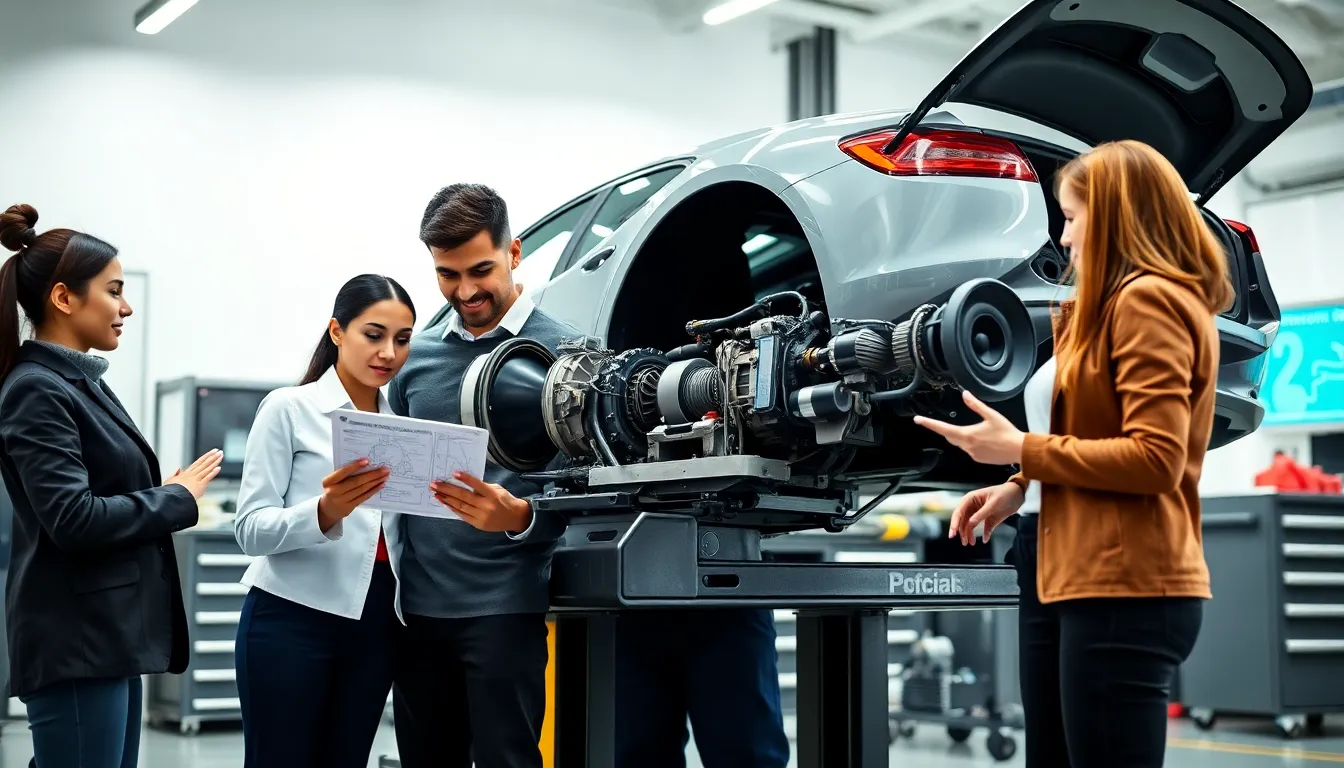Ever wondered if electric vehicles (EVs) have transmissions? You’re not alone. Imagine trying to navigate those sleek vehicles without truly understanding what’s under the hood, or in this case, under the battery. Hilarity aside, transmissions are a core aspect of any vehicle’s performance. In the intriguing realm of EVs, this topic delves deep, revealing how these innovative machines operate. Let’s plug into the juicy details.
Table of Contents
ToggleUnderstanding Electric Vehicle Mechanics

What Is a Transmission?
In traditional vehicles, a transmission is a complex system that helps manage power from the engine to the wheels. It’s responsible for changing gears, which allows the vehicle to adapt to different speeds and driving conditions. This little piece of machinery not only helps drivers maintain optimum performance but also impacts fuel efficiency. By managing how and when the engine delivers power, transmissions play a crucial role in performance, whether the vehicle runs on gasoline or electricity.
For EVs, the case is slightly different. While they might use a form of transmission, it doesn’t quite mirror what ice vehicles rely on. In fact, many electric vehicles boast a much simpler setup, leading to some unique advantages that traditional systems can’t compete with.
Differences Between Electric and Internal Combustion Engine (ICE) Vehicles
How Electric Motor Power Differs
The power delivery mechanism in electric vehicles is fundamentally different from internal combustion engine vehicles. In essence, electric motors deliver maximum torque instantly, without the gradual build-up that comes from traditional engines. This immediate power surge means EVs can dart off the line and reach impressive speeds without waiting for the engine to rev up.
Users of ICE vehicles often find themselves shifting gears and giving some thought to throttle management. But in an EV, the simplicity shines through, it usually relies on a single-speed transmission that allows for smooth acceleration without the shift shock common in traditional setups. So, while drivers of ICE vehicles might be grappling with gear shifts and clutch pedal coordination, EV drivers enjoy the seamlessness of electric propulsion. It’s like going from dial-up to fiber internet in seconds.
The Role of Gears in Electric Vehicles
Single-Speed Transmission Systems
The majority of electric vehicles on the market today use a single-speed transmission system. This kind of setup simplifies the driving experience, eliminating the need for gear shifting. Because electric motors churn out a consistent and high maximum torque, a single gear can effectively meet the driving requirements across a wide speed range.
This straightforward approach is not only user-friendly but also lightens the weight of the vehicle, enhancing overall efficiency. Plus, fewer moving parts mean reduced wear and tear, translating into fewer maintenance headaches and long-lasting performance. Let’s be real, who wouldn’t want that?
Multi-Speed Transmission Systems in Electric Vehicles
While single-speed systems dominate the EV landscape, some manufacturers are experimenting with multi-speed transmissions. These systems can harness the advantages of multiple gears, potentially improving acceleration and energy efficiency. A multi-speed setup can enable better optimization at various speeds, reducing energy loss, particularly at higher velocities.
This is still a budding area of research and development, but in a world where innovation is the name of the game, these technologies signal exciting possibilities for the future of EVs. Each new gear might just become another chapter in the electric vehicle saga.
Advantages and Disadvantages of Electric Vehicle Transmissions
Performance Implications
A primary advantage of electric vehicle transmissions lies in their performance metrics. With single-speed systems providing consistent torque, drivers experience smoother acceleration patterns. There’s no need to wrestle with shifting delays. This immediacy translates to a unique driving experience, making highway merges and sudden stops much more manageable.
But, some argue that multi-speed transmissions could offer finer control over power delivery in specialized circumstances, such as heavy towing or racing. Yet, most everyday drivers may not notice much difference.
Efficiency and Energy Use
When talking efficiency, single-speed systems have the upper hand. They are lightweight and designed to maximize battery performance. Less complexity means less energy loss transferring from the electric motor to the wheels, ensuring more efficient use of battery power compared to the complicated gear meshes seen in ICE vehicles. Nevertheless, multi-speed transmissions could eventually provide enhanced efficiency in specific contexts, making them an area worth watching in future EV developments.
Future Trends and Innovations in EV Transmissions
Potential Developments in Multi-Speed Transmissions
As the electric vehicle industry continues to flourish, manufacturers are eyeing potential developments in multi-speed transmissions for electric vehicles. The goal? Achieve more intuitive driving experiences and improved energy efficiency. These innovations could translate into exciting features such as seamless shifts, better performance under load, and optimized battery use. What will the future hold? Will we see the electric equivalent of a sporty manual shift? Only time will tell.
Impact of Autonomous Technology on Transmissions
With the rise of autonomous driving technology, the dynamics of vehicle transmissions will also evolve. Many industry experts speculate that as self-driving vehicles become the norm, the complexity of traditional gear systems may become obsolete. If cars can drive themselves, who needs to shift gears anyway? This points toward a future where transmissions could be optimized not just for performance but also for smart decision-making capabilities, improving fuel economy and emissions.



